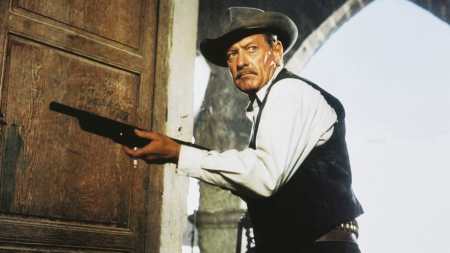The Wild Bunch
 Watching The Wild Bunch, Sam Peckinpah’s magnum opus, you might imagine it should have killed off all Westerns forevermore. Or movies. The film, which celebrates its 50th anniversary on June 18, was designed to flip our violence-craving switch off by giving us splattering, gushing, slow-motion carnage. Instead, to Peckinpah’s chagrin, it fed and reinforced that craving. And yet, to modern eyes, it’s not the copious blood squibs and squirts that feel revolutionary (not when we know it was preceded by Kurosawa and Herschell Gordon Lewis); it’s Lou Lombardo’s time-scrambling editing, which glides from regular to slow motion between shots during the sequences of greatest brutality. Old-school mythmaking met new-school technique and produced, as Pauline Kael had it, a new wine that exploded the old bottle of the Western.
Watching The Wild Bunch, Sam Peckinpah’s magnum opus, you might imagine it should have killed off all Westerns forevermore. Or movies. The film, which celebrates its 50th anniversary on June 18, was designed to flip our violence-craving switch off by giving us splattering, gushing, slow-motion carnage. Instead, to Peckinpah’s chagrin, it fed and reinforced that craving. And yet, to modern eyes, it’s not the copious blood squibs and squirts that feel revolutionary (not when we know it was preceded by Kurosawa and Herschell Gordon Lewis); it’s Lou Lombardo’s time-scrambling editing, which glides from regular to slow motion between shots during the sequences of greatest brutality. Old-school mythmaking met new-school technique and produced, as Pauline Kael had it, a new wine that exploded the old bottle of the Western.
The basic story is older than the medium itself — a band of aging outlaws on one final score. But Peckinpah takes it and tries to strip off all the romanticism that had accumulated around the trope for the past seventy years or so. In retrospect, Gene Hackman’s character in Unforgiven can be seen as a Peckinpah figure, debunking the grand old legends of the West, replacing the pulps’ malarkey with his own cheerfully cynical version. (And I mean cheerfully; despite the gore and grime of The Wild Bunch, its tone is mostly the opposite of grim and gritty. There are a few points when characters join in full-throated nihilistic laughter.) In this savage universe, death is noted and given its due, but only briefly; life is pursuit and retreat, and innocence is represented by a group of children burning ants and a scorpion alive.
In such a godless place, only killers and thieves with some sort of moral code, however shaky, stand a chance of existing with dignity. Our anti-hero, Pike Bishop (William Holden), says that if we can’t be loyal to the men we ride with, we’re no better than animals. But no one else is obligated to share that ethos. The movie is set in 1913, possibly a surprise to newcomers, and the appearance of an automobile seems really out of place in the reality established in the film up to that point. But it’s not the car that’s the anachronism, it’s these men, who might have made their bones after or even during the Civil War, and who don’t belong in the 20th century. Moral codes are becoming an endangered species. In one short year, all the technology seen or talked about by these men — such as the machine gun that gets such play during the climax — will be put to use in the first Great War. For most of the movie, though, our anti-heroes — including Ernest Borgnine as sarcastic Dutch and Ben Johnson and Warren Oates as the loutish Gorch brothers — ride through a world of six-shooters, rifles, maybe dynamite.
The pictorial style of the film — classical, elegiac — bumps up against the technique that fractures and prolongs death. Peckinpah uses pure cinema to make his point about the world passing these men (this genre) by. The Peckinpah figure here might be Deke Thornton (Robert Ryan), formerly an associate of Pike, now deputized by the railroad to find and kill Pike and his gang. Deke doesn’t take any pleasure in violence, and isn’t like some of the human buzzards in his posse who rush to denude the dead. Deke seems to see the writing on the wall, and Ryan plays him with a sad gravitas typical of his great late-career performances. (Indeed, if not for later triumphs by Oates and Johnson, I’d be tempted to say Peckinpah got career-capping work out of everyone here.) A lot of The Wild Bunch, while working to be iconoclastic, is also archetypal. If you’re going to redefine painting, you still have to do it onto a surface, not in thin air.
And so The Wild Bunch is projected onto a big wide screen, larger than almost anything (though Peckinpah isn’t much interested in aping Sergio Leone’s near-parodic gigantism). The scale is epic though not inflated. The simpler men in the gang seem capable of joy, fleeting though it is (literally soaking in wine with topless women — the nascent second-wave feminism of its era touches this film not in the slightest, by the way). The older, wiser men can laugh ruefully at the abyss but have stared into it too often to forget it for long. That’s Peckinpah in sum. This lengthy Panorama movie-movie, with its crimson eruptions playing out in open air and sunshine, turning the dry Mexican sand into bloody mud, may be Peckinpah’s most personal film; he’s both Pike, an old outlaw feeling outmoded, and Deke, a former outlaw renouncing disorder. Peckinpah and his film are profoundly ambivalent about which is the better man, and fifty years later that may remain more of a shock than the arterial geysers.
Explore posts in the same categories: one of the year's best, western
Leave a comment